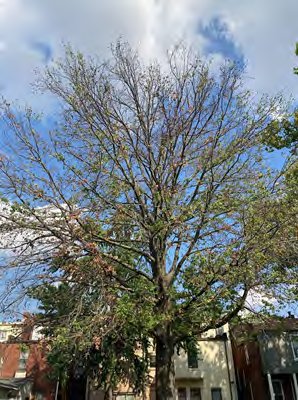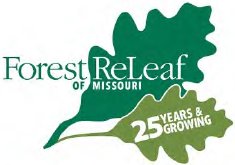AgEBB-MU CAFNR Extension
Green Horizons
Volume 25, Number 3
Fall 2021
 |
| A sad sight to behold....badly infected with gouty oak gall, this pin oak has little hope for long-term survival. |
Species Spotlight: Pin Oak
Mark Halpin, Forestry Manager, Forest ReLeaf of Missouri
Pin Oak, Quercus palustris was formerly the go-to landscape oak and fine specimens still abound in our region. Although it commonly grows to 60-70' in height by 40-50' in spread, it can exceed 100' in ideal conditions. It reaches maturity swiftly for an oak, as over 2' of growth per year is possible. Palustris means "of the swamp" and like many bottomland species it can tolerate compacted soil, the arch nemesis of urban trees. These traits, combined with its ease of propagation, made it hugely popular in the nursery industry for much of the 20th century.
Unfortunately, pin oak has a weakness: It is highly susceptible to iron chlorosis, a condition aggravated by the high-pH soils common to urban areas, resulting in sickly yellow leaves. Pin oaks have always been susceptible to galls as well, particularly gouty and horned oak gall. In recent years the combined stressors of poor soil conditions, pollution, and "miscellaneous" (car accidents, sidewalk repair, etc. etc.) have caused these galls to move from the "aesthetic nuisance" category to "nail in the coffin". The pin oak is now often a shadow of its former self. Its distinctive branching habit - upper branches ascending, middle branches reaching straight out and lower branches hanging down to form a "skirt" - is reduced to a prematurely defoliating outline, bristling with gnarly galls. The dull brown of the dying limbs is offset by the sickly yellow pallor of the few leaves and (if you're really unlucky) the white patches of Hypoxylon fungi feeding on the decaying wood.
 |
Heavily infested trees should be removed in many cases; chemical treatments are ineffective and once the feedback loop of environmental stress and opportunistic pathogens begins it is almost impossible to reverse (although please, consult an ISA Certified Arborist before making these decisions). Reducing the populations of the wasps that produce the galls, and removing hazardous trees is of paramount importance. As for lightly or uninfected pin oaks, good ol' Plant Health Care has never been more important. Healthy trees resist pathogens much more effectively, so if you have a mature pin oak and don't feel like spending thousands of dollars on a removal and waiting another half-century to recoup your shade, spend a few hundred on making that tree happy instead. Eliminate turf grass around it and provide it with a nice mulch bed. Keep vehicles off its root system at all costs, and if the soil is compacted (it probably is) consider having some aeration done with an air tool (again, consult an arborist). In extreme cases of chlorosis, iron treatments can provide fast relief for a growing season while you work on more long-term solutions.
If you are planting an oak (please do!), consider a Nuttall or Shumard instead. For the time being, let's let the pin oak retire from landscape service and take some well-deserved rest at its home in the bottomland forests.
